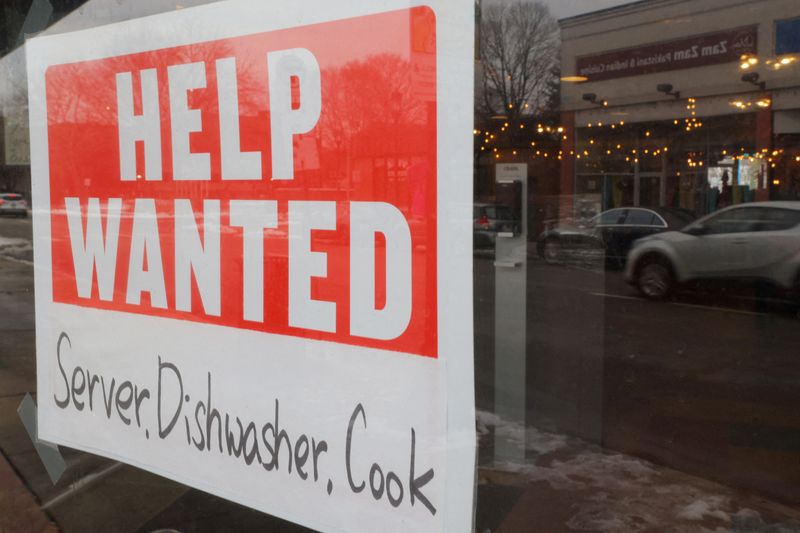By Lucia Mutikani
WASHINGTON (Reuters) - U.S. job growth accelerated in January and wages increased by the most in nearly two years, signs of persistent strength in the labor market that could make it difficult for the Federal Reserve to start cutting interest rates in May as currently envisaged by financial markets.
The closely watched employment report from the Labor Department on Friday also showed the unemployment rate at 3.7% last month, remaining below 4% for two consecutive years, the longest such stretch in more than 50 years. More jobs were created in 2023 than previously estimated. January's blowout job count and large wage gains dashed prospects of a rate cut next month. Financial markets lowered the odds of a May cut.
Resilient demand and strong worker productivity are likely encouraging businesses to hire and retain more employees, a trend that could shield the economy from a recession this year.
"Given the Fed now wants strong job growth, as (Fed Chair) Jerome Powell told us just two days ago, this report should not discourage the Fed from cutting rates," said Chris Low, chief economist at FHN Financial in New York. "By the same token, however, it is not going to encourage them to rush into rate cutting."
Nonfarm payrolls increased by 353,000 jobs last month, the largest gain in a year, the Labor Department's Bureau of Labor Statistics said. The economy added 126,000 more jobs in November and December than previously reported. Payrolls shrugged off the drag from winter storms, which reduced the average workweek.
Though annual "benchmark" revisions showed 266,000 fewer jobs were created in the 12 months through March 2023 than previously reported, employment gains last year totaled 3.1 million. Before the revisions, the job count for 2023 had been estimated at 2.7 million.
Economists polled by Reuters had forecast payrolls increasing 180,000 last month. Estimates ranged from 120,000 to 290,000. Job growth in January was above the monthly average of 255,000 in 2023. Roughly 100,000 jobs per month are needed to keep up with growth in the working age population.
The report suggested that economic growth momentum from the fourth quarter spilled over into the new year. It also challenged the notion that the economy was heading for a "soft-landing." President Joe Biden welcomed the report saying "America's economy is the strongest in the world."
Average hourly earnings increased 0.6% last month, the biggest gain since March 2022, after rising 0.4% in December. In the 12 months through January, wages increased 4.5% after advancing 4.3% in December.
Wage growth is running ahead of the 3.0% to 3.5% range that most policymakers view as consistent with the U.S. central bank's 2% inflation target, supporting views that the Fed will not move quickly to lower borrowing costs.
Financial markets now see a less than 60% chance of the Fed cutting rates at its April 30 and May 1 meeting. The Fed left interest rates unchanged on Wednesday, but Chair Jerome Powell told reporters that rates had peaked. Since March 2022, the central bank has raised its policy rate by 525 basis points to the current 5.25% to 5.50% range.
Stocks on Wall Street were trading higher. The dollar rose against a basket of currencies. U.S. Treasury prices fell.
BROAD GAINS
Most economists were dismissive of recent high-profile layoffs, including 12,000 job cuts announced by United Parcel Service (NYSE:UPS) this week, arguing that the focus should be on worker productivity, which has exceeded a 3% annualized growth pace for three straight quarters, and cooling labor costs.
Employers are generally wary of sending workers home following difficulties finding labor during and after the COVID-19 pandemic. But some companies, which enjoyed a boom in business during the pandemic, are laying off workers as conditions return to normal.
"We know that most layoffs in recent years were from cost cutting and not from weaker demand," said Jeffrey Roach, chief economist at LPL Financial (NASDAQ:LPLA) in Charlotte, North Carolina. "This means businesses are in a good position despite the macro headwinds and uncertainty about growth expectations."
Employment gains last month were across the board, with nearly two-thirds of industries adding jobs, the most in a year. Professional and business services added 74,000 jobs. Temporary help services employment, a harbinger for future hiring rebounded by 3,900, ending 21 straight months of declines.
Healthcare payrolls rose by 70,000 jobs, spread across ambulatory, hospitals as well as nursing and residential care facilities. Retail trade employment increased by 45,000 jobs, while manufacturing hired 23,000 more workers. Government payrolls increased by 36,000, driven by federal government hiring as well as local government, excluding education.
There were also job gains in construction, transportation and warehousing, utilities, leisure and hospitality sectors. But the mining and logging industry shed 6,000 jobs.
The average workweek declined by 0.2 hour to 34.1 hours. Outside the pandemic recession, that was the shortest since June 2010. Some economists viewed this as a sign that layoffs were imminent, but others blamed the winter storms. About 553,000 people did not report for work in mid-January because of bad weather, the largest for any January since 2011.
The unemployment rate was at 3.7% in January. New population estimates were incorporated into the household survey, from which the unemployment rate is derived, creating a break in the series. The population controls had no impact on the jobless rate, which was at 3.7% in December.

There was also no impact on the labor force participation rate, or the proportion of working-age Americans who have a job or are looking for one, which held at 62.5%. But the size of the civilian labor force was reduced by 299,000. There was an uptick in the number of people working part-time for economic reasons and those experiencing longer spells of unemployment.
"The overall picture looks to be one of a still quite strong labor market, and an economy starting 2024 with plenty of forward momentum," said Michael Feroli, chief U.S. economist at JPMorgan in New York.